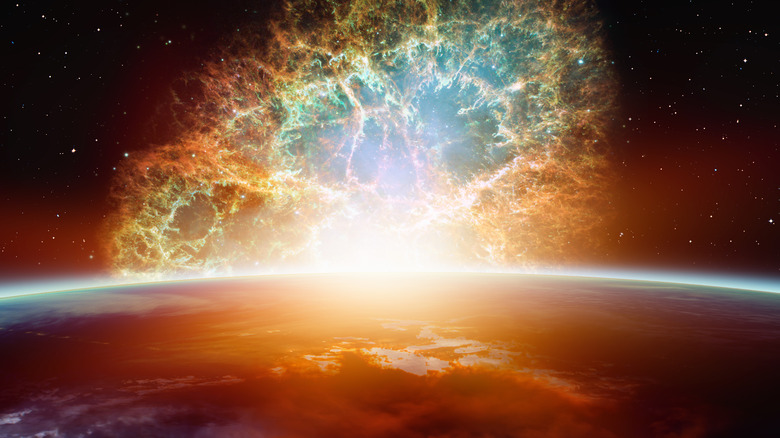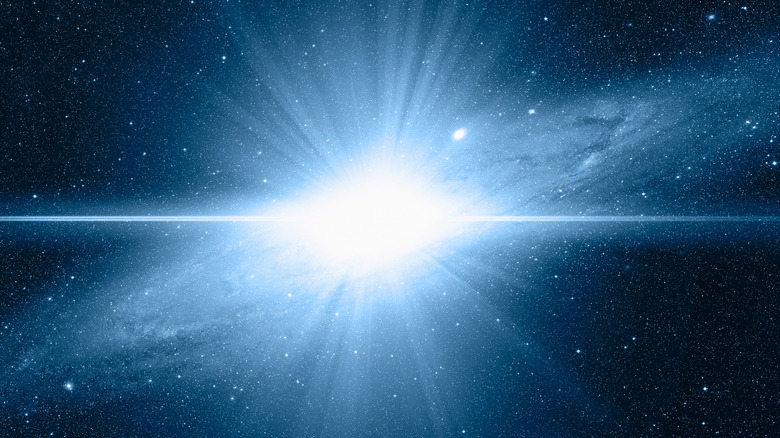Here's What Make Supernovae The Most Intense Explosions In The Universe
The visible universe is a big place. Like, really, really big — some 93 billion lightyears across (via Futurism). To put that in perspective, that's like running 25 billion back-to-back marathons, and then running that entire distance again another 834 billion times. By then you'd be more than 99.9% done, though you'd still have something like 477 quintillion miles to go. That's just the visible universe, mind you. Scientists believe the total universe is more than 250 times that size (via MIT Technology Review). In all that space, among all those countless points of light, NASA says the biggest explosions humans have ever observed come from supernovae.
Broadly speaking, there are two types of supernova. A Type I supernova happens when two stars are orbiting each other and one essentially eats the other. Type II supernovae are the final death throes of enormous solitary stars. Luckily, Sol — aka, Earth's star, or what we like to think of as the sun — has no companion star, and its mass is about eight times too small to end its life as a Type II supernova (it will still consume the Earth in a few billion years anyway, but that's a story for another time).
When a star goes supernova, it can outshine an entire galaxy of billions of stars for months and birth a black hole in the process (via Nature). These explosions are so powerful, they can sterilize every planet within a hundred trillion miles. Those are some serious pyrotechnics.
How do they cram all the blam?
To understand where supernovae get all their power, it's important to understand how stars work. First, they're giant balls of burning gas, usually hydrogen, the most abundant element. Stars are so massive that their inward gravitational pull compresses the hydrogen at its core until it fuses into helium. This is the same type of fusion energy that scientists hope to harness as a clean power source on Earth.
A presentation from Caltech explains that the heat and light generated from the fusion in a star's core push against the star's gravity. The opposing inward and outward forces cancel out in a temporary equilibrium. Helium eventually builds up in the star's core, interrupting the fusion reaction and disturbing the overall balance.
For smaller stars, this is where they stop and slowly cool into the far future — that is, unless they've got a nearby partner they can steal mass from until they achieve a runaway nuclear reaction (via Space), which is a phrase that, when describing an entire star, leads to a Type Ia supernova. For larger stars, they start burning their helium into heavier and heavier elements until the fusion reactions no longer counteract gravity (via Stanford). The entirety of the star collapses on itself in a matter of seconds and then violently bounces back out into the universe like a stellar bomb — a Type II supernova. With a supernova going off every 10 seconds though, should we be worried?
Should you be looking at supernova insurance?
According to the excellent video by Kurzgesagt above, you can rest easy — at least where supernovae are concerned. Our solar system formed within a bubble left behind by one such ancient explosion, so in a way, we actually owe our existence to supernovae. According to a 2019 review in the journal "Science," many of the atoms that make up your body — oxygen, sodium, calcium, and others — were forged within and distributed through cataclysmic supernova detonations, so without supernovae, you wouldn't be here.
Still, one can have too much of a good thing, and in the case of supernovae that means being too close. In a 2020 paper in "Proceedings of the National Academy of Sciences," scientists suggest that the "kill zone" around a supernova is about 33 lightyears and that such an explosion at about twice that distance may have been responsible for a major extinction event on Earth about 350 million years ago.
Observations by the ESA suggest a supernova goes off within our own Milky Way galaxy about every 50 years or so. Even though the Milky Way is just a tiny spec in the expanse of space, it's still unfathomably large on a human scale, so we have plenty of breathing room. There are only a handful of stars that are close enough that life on Earth would be threatened if they went supernova, and scientists don't expect them to go off any time soon.

